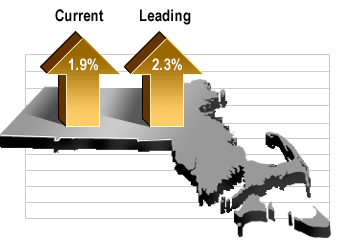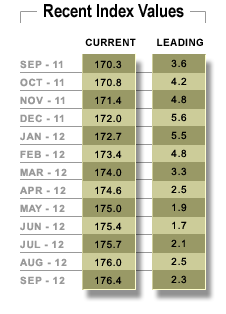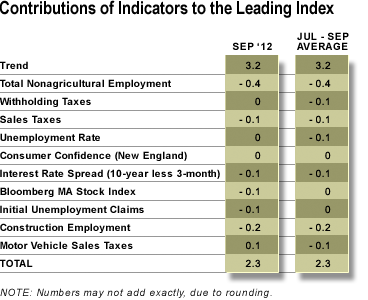State economy slows notably in Q3, UMass journal reports
Near-term outlook is for continued slow growth and little job creation.
October 2012
 The growth in Massachusetts real gross domestic product increased at an annual rate of 1.9 percent in the third quarter of 2012 according to the latest MassBenchmarks Current Economic Index released today by MassBenchmarks, the journal of the Massachusetts economy published by the UMass Donahue Institute in collaboration with the Federal Reserve Bank of Boston.
The growth in Massachusetts real gross domestic product increased at an annual rate of 1.9 percent in the third quarter of 2012 according to the latest MassBenchmarks Current Economic Index released today by MassBenchmarks, the journal of the Massachusetts economy published by the UMass Donahue Institute in collaboration with the Federal Reserve Bank of Boston.
In contrast, the growth in U.S. real gross domestic product increased at an annual rate of 2.0 percent in the third quarter, according to the Advance Estimate released earlier today by the US Bureau of Economic Analysis. In the first and second quarters of 2012, the state’s economy grew at revised annual rates of 2.0 and 3.0 percent respectively, well below the 4.0 percent rate of growth originally reported for each quarter earlier this year. In the first two quarters of 2012, the U.S. economy grew at annual rates of 2.0 percent and 1.3 percent respectively.
The MassBenchmarks Leading Economic Index for September was 2.3 percent, and the three-month average for July through September was also 2.3 percent. The leading index is a forecast of the growth in the current index over the next six months, expressed at an annual rate. Thus, it indicates that the economy is expected to grow at an annualized rate of 2.3 percent over the next six months (through March 2013).
 The state's economy slowed sharply in the third quarter of 2012. Payroll employment growth slowed from an annualized rate of 1.6 percent in the second quarter to 0.2 percent in the third and the unemployment rate increased by half a percentage point during the third quarter, from 6.0 percent in June to 6.5 percent in September. While wage and salary income grew at a respectable annualized rate of 5.5 percent in the third quarter, spending on items subject to the regular sales tax and motor vehicles tax declined by an annual rate of 1.5 percent in the third quarter, according to state withholding and sales tax data.
The state's economy slowed sharply in the third quarter of 2012. Payroll employment growth slowed from an annualized rate of 1.6 percent in the second quarter to 0.2 percent in the third and the unemployment rate increased by half a percentage point during the third quarter, from 6.0 percent in June to 6.5 percent in September. While wage and salary income grew at a respectable annualized rate of 5.5 percent in the third quarter, spending on items subject to the regular sales tax and motor vehicles tax declined by an annual rate of 1.5 percent in the third quarter, according to state withholding and sales tax data.
Economic difficulties in Europe and the global growth slowdown continue to act as a drag on the state’s economy. State merchandise exports in the first eight months of the year were down 5.9 percent compared to the same period last year. In contrast, U.S. exports grew 5.6 percent during the same period. The Commonwealth’s weaker performance reflects its higher reliance on Europe as an export destination. Stagnant demand for information technology also contributed to the state slowdown. Worldwide sales of semiconductors in the first eight months of this year were below last year, particularly in Europe and the Americas. Nominal U.S. investment in information and processing equipment and software declined slightly in the second and third quarters of this year, and in the third quarter was only 1.4 percent higher than the third quarter last year.
"If the state's economy continues to grow at the pace predicted by the leading index, and if productivity growth returns to its trend rate, real Massachusetts gross domestic product is expected to grow at 2.3 percent annual rate in the fourth quarter of this year and in the first quarter of 2013," noted Dr. Alan Clayton-Matthews, MassBenchmarks Senior Contributing Editor and Associate Professor of Economics and Public Policy at Northeastern University, who compiles and analyzes the Current and Leading indices. "Given expected productivity growth, this trend is consistent with an expectation of virtually no net employment growth in Massachusetts over the next six months," Clayton-Matthews added.
Despite the poor recent overall economic performance and the slow outlook for the rest of the year, some knowledge-based and technology sectors continue to do well. Employment in computer systems, consulting, scientific research and development, software, and durable manufacturing have continued to increase despite weaknesses in other sectors of the economy.
 The 10 indicators that comprise the leading index usually do not all move in tandem. Typically, some may indicate an expectation of faster than average growth, while at the same time others may indicate an expectation of slower than average growth. The following table accounts for the contributions of each towards faster or slower growth than the long-term trend of 3.2 percent. The index value is their sum.
The 10 indicators that comprise the leading index usually do not all move in tandem. Typically, some may indicate an expectation of faster than average growth, while at the same time others may indicate an expectation of slower than average growth. The following table accounts for the contributions of each towards faster or slower growth than the long-term trend of 3.2 percent. The index value is their sum.
In September, one indicator, motor vehicle sales taxes, contributed to a forecast of above-trend growth. Six indicators contributed to below-trend growth: total nonagricultural employment, sales taxes, the interest rate spread between 10 year and 3 month U.S. Treasury securities, the Bloomberg stock index for Massachusetts, initial unemployment claims, and construction employment. Three indicators contributed to average-trend growth: withholding taxes, the unemployment rate, and consumer confidence.
In the three-month period July through September, no indicators contributed to a forecast of above-trend growth. Seven indicators contributed to below-trend growth: total nonagricultural employment, withholding taxes, sales taxes, the unemployment rate, the interest rate spread between 10 year and 3 month U.S. Treasury securities, construction employment, and motor vehicle sales taxes. Three indicators contributed to average-trend growth: consumer confidence, the Bloomberg stock index for Massachusetts, and initial unemployment claims.
The current and historical quarterly estimates for state domestic product growth include adjustments for changes in productivity growth. These adjustments are estimates of the quarterly deviations from the trend in the growth of the ratio of output to employment and output to wage and salary income. In the third quarter, these adjustments subtracted 0.5 percentage points from the annual rate of growth. In the second quarter of 2012, these adjustments subtracted 0.6 percentage points from the annual rate of growth. In the first quarter of 2012, these adjustments subtracted 2.8 percentage points from the annual rate of growth. For the forecast of state domestic product growth for the fourth quarter of this year and the first quarter of next year, productivity growth is assumed to return to its long-term trend. The methodology and rationale for these adjustments are available from the author upon request.
Several recent months of the indices are revised each release. These revisions are a result of the statistical method used to create the index, as well as revisions in the underlying indicators.
--------
All of the indicators except interest rates refer to Massachusetts. The current index is composed of four indicators: nonagricultural employment, withholding taxes, sales taxes, and the unemployment rate. The leading index includes these four current indicators plus the other six (leading) indicators in the contributions table. All of the indicators are as of September, except for interest rates, and the Bloomberg stock index for Massachusetts, which are through October 23. The MassInsight Consumer Confidence Index is released every third month. Intervening months are interpolated, and changes in the Conference Board's Consumer Confidence Index for the U.S. are used to extrapolate to the current month of the index, as needed. Series measured in dollars, i.e., withholding taxes, sales taxes, the Bloomberg stock index, and motor vehicle sales taxes, are deflated by the U.S. consumer price index for all urban consumers, excluding food and energy.
For a description of the methodology used to construct these indices, see: Alan Clayton-Matthews and James H. Stock, "An application of the Stock/Watson index methodology to the Massachusetts economy," Journal of Economic and Social Measurement, vol. 25 (1998/1999), pp. 183-233.
Dr. Alan Clayton-Matthews
Senior Contributing Editor, MassBenchmarks
Associate Professor of Economics & Public Policy
School of Public Policy and Urban Affairs
Northeastern University
October 26, 2012

